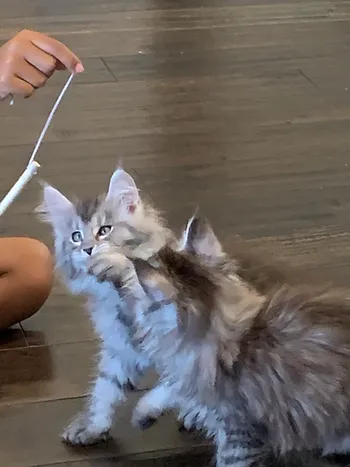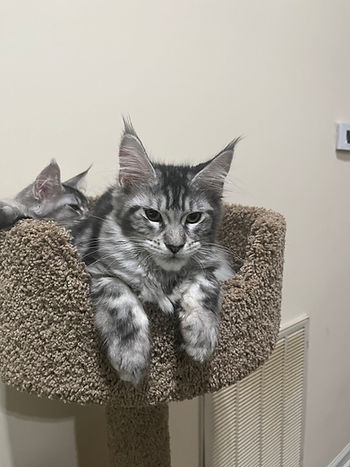7 Insights on Cat Scratch Fever and Maine Coon Kittens
Description
Learn if Maine Coon kittens in California can spread Cat Scratch Fever and discover key facts about this infection.
Cat Scratch Fever, medically known as Cat Scratch Disease (CSD), is an infection caused by the bacterium Bartonella henselae. Despite its somewhat whimsical name, it’s a condition that cat owners should take seriously. This article delves into the intricacies of Cat Scratch Fever, providing factual, professional insights into its causes, symptoms, presentation, treatment, and prevention, all while keeping the reader engaged with a blend of informative and captivating content.
Cat Scratch Fever is more common than many pet owners assume. The Centers for Disease Control and Prevention (CDC) estimates that there are around 12,000 cases of Cat Scratch Disease reported each year in the United States alone. This highlights the importance of understanding this infection and its implications for cat owners.
Understanding Cat Scratch Fever is essential for all cat owners and pet enthusiasts.
What is Cat Scratch Fever?
In addition to direct scratches or bites from cats, Cat Scratch Fever can also be transmitted through exposure to environments where infected fleas reside. Hence, ensuring that your home is flea-free is a vital part of protecting yourself and your family.
Cat Scratch Fever is transmitted to humans typically through a bite or scratch from an infected cat or, less commonly, through contact with cat saliva on a fresh scratch or cut. The bacteria Bartonella henselae lives in the fleas that cats often carry, making flea control an essential aspect of prevention.
Recognizing the symptoms of Cat Scratch Fever is crucial for early intervention. For example, if a person notices persistent swelling around a scratch or bite, accompanied by fever or headache, seeking medical advice promptly can lead to a faster recovery.
Symptoms of Cat Scratch Fever
The symptoms can range from mild to severe and might include:
- Localized Infection: Redness, swelling, and sometimes pus at the site of the scratch or bite.
- Lymph Node Swelling: Often, one or more lymph nodes near the site of the infection become significantly enlarged and tender, which can last for weeks or months.
- General Symptoms: Fever, fatigue, headache, and loss of appetite might occur, resembling flu-like symptoms.
In rare cases, particularly those with compromised immune systems, CSD can lead to more severe complications like:
Understanding the rare complications associated with Cat Scratch Fever can also help individuals take preventive measures seriously. Neurological complications, while uncommon, can significantly impact quality of life, underscoring the need for vigilance.
- Neurological Effects: Including encephalitis or seizures.
- Eye Infections: Known as Parinaud’s oculoglandular syndrome.
- Systemic Infections: Such as endocarditis in the heart.
Diagnosis
Diagnosing Cat Scratch Fever involves:
- Clinical Assessment: Based on symptoms and history of cat contact.
- Serological Tests: Blood tests to detect antibodies against Bartonella henselae.
- Lymph Node Biopsy: Sometimes, to confirm the presence of the bacteria.
Treatment
Most cases of Cat Scratch Fever resolve on their own without specific treatment. However, here’s what might be involved:
- Symptomatic Relief: Pain relief for swollen lymph nodes, fever reducers, and anti-inflammatory medications.
- Antibiotics: In severe cases or for those with weakened immune systems, antibiotics like azithromycin or doxycycline might be prescribed.
Prevention
Preventing Cat Scratch Fever is multifaceted:
- Flea Control: Regular application of flea treatments on your cat is crucial. Fleas are the primary vector for Bartonella henselae.
- Cat Care: Avoid rough play that might lead to scratches or bites. Keep your cat’s claws trimmed.
- Hygiene: Wash any scratches or bites immediately with soap and water. Avoid kissing cats around the mouth or allowing them to lick open wounds.
- Awareness: Educate children on gentle interaction with cats to minimize scratch risk.
Living with Cats and Cat Scratch Fever
In mild cases, home remedies such as warm compresses can alleviate discomfort. However, it is essential to consult a healthcare provider if symptoms persist or worsen over time to rule out more serious conditions.
Living with cats does not mean you’re destined to get Cat Scratch Fever, but awareness and precaution are key:
- Monitor Cats Health: Cats might not show symptoms even when carrying the bacteria, so keeping your pet healthy is a general preventive measure.
- Public Education: Educating cat owners and the public about CSD can significantly reduce its incidence.
Conclusion
While generally not severe, this infection requires attention due to its potential complications, especially in those with compromised immune systems. By understanding how it’s transmitted, recognizing the symptoms early, and taking preventive measures, cat lovers can continue to enjoy the companionship of their feline friends safely. Remember, a little prevention goes a long way in ensuring both your health and the well-being of your cat. Please note all cats can spread this infection, including Maine Coon Cats and Maine Coon Kittens.
Implementing an effective flea control program goes beyond just treating your cat. Regularly vacuuming your home, washing pet bedding, and using flea prevention products in your living space can significantly decrease the risk of Cat Scratch Fever transmission.
Moreover, understanding cat behavior is essential. Cats scratch and bite during play, and recognizing the signs of overstimulation can prevent injuries. Providing appropriate toys can redirect their energy away from human hands.
Teaching children about proper interactions with cats can be an effective preventive measure. Engaging young kids in discussions about animal body language can help them understand when a cat wants to play and when it needs space, reducing the chances of scratches.
In conclusion, proactive education and awareness regarding Cat Scratch Fever can empower cat owners and the general public. By discussing this condition and sharing preventive strategies, we can significantly mitigate the risks associated with it.
As we continue to share our lives with cats, let us also share knowledge and practices that promote a healthy relationship between humans and our feline companions. Together, we can ensure a safe and loving environment for both.











